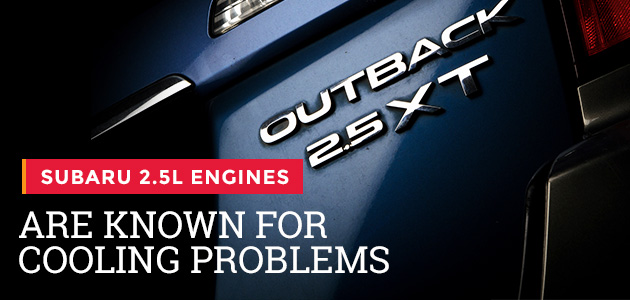
Subaru 2.5L engines have a mixed history of cooling, head gasket and oil leaks. There are specific ways to test a Subaru 2.5L engine for leaks, and not all testing methods provide reliable results.
- There’s a difference between OEM and aftermarket parts for Subaru engines
- Bar’s Leaks products have helped hundreds of thousands of Subaru owners insure against and solve cooling system, head gasket and oil leaks
Out on the open road, a vehicle’s engine can get mighty hot amidst the high speeds and sharp inclines of freeways and steep terrains. Under the hood of each car lies a series of complex components, some of which heat up in the process of powering the engine, and others that exist to counter these effects and prevent things from overheating. From the thermostat and fans to the radiator and coolant reservoir, each part relies on the other to keep the engine cool for safe driving.
- Common Cooling Problems
- Subaru Coolant Leaks
- Subaru Oil Leaks
- Faulty Testing of Subarus
- How to Test for Cooling Problems
- Basic Owner Maintenance
- Cost of a Head Gasket Fix
- Stop-Leak Products
- Become an Instant Mechanic
Sometimes, however, things go awry, and a car experiences cooling problems that make it difficult — if not outright dangerous or impossible — to continue driving. Unfortunately, such problems are hard to identify, they’re costly to repair. Such has been the case with Subaru 2.5L models, which are known for cooling system issues. Fortunately, it’s possible to keep your Subaru in good driving condition as long as you have the proper information, perform the needed maintenance and keep reputable stop–leak products on hand should the need arise.
Cooling Problems Due to Fan Failure
As with most vehicles, if a Subaru overheats while being driven at slow speeds, it’s likely a failure of the cooling fan to power up completely. With applications made abroad — including parts made by the Japanese automaker — the speed of the cooling fan is controlled by a pulse–modulated fan motor. By way of contrast, in domestically made applications, fan speeds are activated by the powertrain control module. Either way, a fan can be diagnosed with the use of a code reader. A code reader is essentially an embedded computer (called the ECU, or Electonic Control Unit) module that a dealership uses to scan the engine for ‘diagnostic’ codes so they can see what’s wrong at a glance. Today’s cars are basically rolling computers, and the ECU will ‘throw a code’ if it detects something is wrong with the engine. The codes give a very accurate, high-level picture of the engine’s condition. If the car has ‘thrown a code,’ then it means the ECU has detected something awry and has logged a code so that techs can begin diagnosis.
Coolant Corrosion in the Radiator

If your Subaru overheats out on freeways and while driving up hills, it’s likely due to a lack of coolant flow to the radiator. As with other vehicles manufactured overseas, clogs can easily form in the cooling tubes of Subaru radiators due to very thin cross-sections. Despite the fact that most original equipment (OE) coolants are formulated to last beyond the 100k mileage mark, the anti–electrolytic additives can degrade and cause corrosion within the radiator.
Dirt and Debris in Radiators
When any kind of dirt or debris gets lodged between the radiator and A/C condenser, it hampers air flow. The old fashioned solution for cases like these would consist of soap and hosed water at low pressure, but today it’s wiser to visit a technician for debris removal, or perform a full radiator flush using a proven solution.
Pressure Cycling
Over time, pressure cycling can wear down the components of a cooling system. When pressure cycling occurs, coolant is forced by the radiator into the reservoir. Once cooled, it’s sucked back out. While this breath in/breath out effect brings air into the system, it also wears out the radiator over time.
Coolant: From the Radiator to the Coolant Reservoir
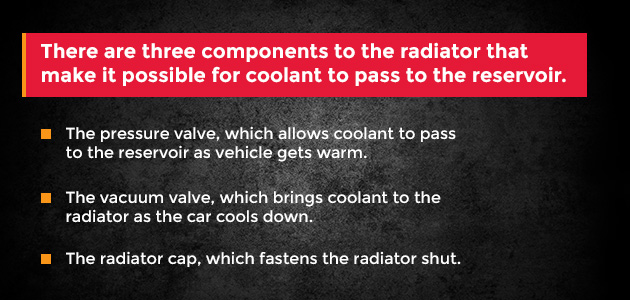
There are three radiator components that make it possible for coolant to pass to the reservoir.
- The pressure valve, which allows coolant to pass to the reservoir as the vehicle gets warm.
- The vacuum valve, which brings coolant to the radiator as the car cools down.
- The radiator cap, which fastens the radiator shut.
Head Gasket Failure
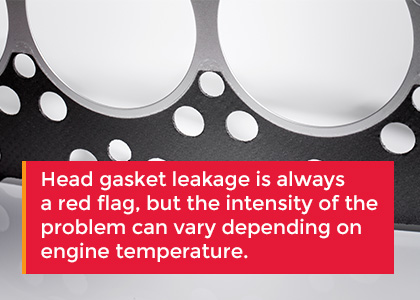
Head gasket leakage (also called a ‘blown head gasket’) is always a red flag, but the intensity of the problem can vary depending on engine temperature. When it does occur, however, one of the following symptoms is usually the cause: a cold system with gases trapped in a cold thermostat, or disappearing coolant with no apparent leakage.
Cold Coolant + Closed Thermostat
When the system is cold, a head gasket leak could cause gasses to get trapped inside. With no way to escape from the closed thermostat, gas pressure can mount inside the engine and cause a reverse flow of coolant through the radiator and back to the reservoir. When worse comes to worst, the reservoir overflows, the coolant is lost and the system overheats.
Empty Coolant Reservoir + No Signs of Leakage
The other symptom involves leakage with no actual evidence. In this situation, the coolant repeatedly needs replenishing, despite there being no trace of oil or fluid on the ground. The likely reason is that coolant is being sucked into the head gasket and ejected from the exhaust. Signs of this occurring include coolant residue on the spark plug insulator, which indicates that coolant has entered the cylinder; and milky brown engine oil, which would prove that the head gasket has leaked. Another sign we talk to customers about all the time is white exhaust smoke. This indicates coolant loss via a cracked or warped cylinder head, a cracked engine block, or head gasket failure caused by severe or chronic overheating. Once coolant leaks into your car’s cylinders or into the combustion chamber itself, you will see telltale white exhaust smoke.
Testing the Engine After Radiator Maintenance
If the radiator in a Subaru is repaired or replaced, it’s best to test the vehicle before taking onto the road to ensure that the engine won’t overheat again. After all, there’s nothing worse than spending good money to get your car back into working condition, only to discover the hard way that the actual problem hasn’t been fixed. To prevent this from happening, have your technician inspect your vehicle and explain that the coolant sensor and thermostat are properly calibrated. Furthermore, warm up and cool down the engine to test the reliability of the thermostat and sensor, and to vent any air that might be stuck in the cooling system.
Subaru Coolant Leaks
In phase two 2.5L models, head gaskets are known to leak in several ways. Models made before 2003 have been notorious for coolant leaks, which generally occur at the left–side gasket. The problem drew protests that prompted Subaru to extend its warranty plan and add an anti–leak cooling system conditioner. In order to stop leaks before they get out of hand, the engine’s bottom should be inspected by a technician during each oil change.
Subaru Oil Leaks
Like all cars, 2.5L models can also leak oil, but Subaru’s horizontal engine design makes it easier to spot the problem the moment it starts. As with head gaskets, the engine should be inspected by a technician during each oil change for evidence of leaks. It must be stated that gasket leaks can and do persist without the formation of spots on the driveway. Subarus, in fact, are equipped with a fiber–lined pan underneath that captures and absorbs droplets of oil and coolant. During an inspection, the technician needs to check this pan to determine whether a leak has occurred since your last checkup.
Combustion Chamber/Cooling System Breach
Internal failure can also cause head gasket leaks in a 2.5L Subaru. This results from conflict between the cooling system and the combustion. Unfortunately, this type of leak often goes undetected at the early, reversible stages. If the problem isn’t remedied, however, it can lead to vehicle overheating and excessive oil consumption.
Stop–Leak Remedies vs. Head Gasket Repair
If there’s a silver lining when it comes to leaks, it’s in the time that you have to decide whether or not to fix the gasket immediately, or to wait and save until the next oil change. This allows you to budget for the repair costs, or consider if you might be ready to trade in the vehicle for something newer and better. There aren’t many car problems that give you this option. For example, if the timing belt snaps, there’s no time to budget or contemplate whether you want to pay for repairs now or later; it’s a problem that has to be fixed immediately in order for the car to operate.
Subaru Cooling System Leaks: The Big Breach
Of course, you’re not allowed any time to deliberate on repairs if the leak involves an overflow of combustion pressure and heat into the coolant. In cases like these, there are two critical problems at play: the coolant system gets hit with far more pressure than it’s built to withstand, and the coolant takes so much heat that it can no longer keep the engine cool. In most Subarus, the radiator cap will let coolant pass into the system at 15 psi, whereas the combustion chamber could send as much as 175 psi. of pressure to the cooling system when a breach occurs. Not only is this far too much pressure for the cooling system, the resultant heat could exceed 500 °F, which is far beyond the reading capacity of a cooling system’s temperature gauge. Consequently, the coolant will get pushed from the radiator and out onto the ground, and the engine will overheat.
Faulty Testing of Subaru 2.5L Models
Unfortunately, technicians often fail to properly diagnose problems such as breaches in 2.5L models. Confusingly, Subarus often display inconsistent symptoms during tests, such as when the engine gets hot without overheating, but then overheats once it’s back out on the road. In some cases, technicians keep missing the actual combustion/coolant conflict, and instead attribute the problems to other issues, such as the thermostat, cooling fans or radiator. One by one, each of these components are replaced, but to no avail.
Reasons Why Subaru Tests Can Be Inaccurate
A Subaru test can be inaccurate because it’s performed while the engine is either cool or only lukewarm. For instance, if the engine is cold and the pressure is only 15 to 20 psi, the breach could be hard to detect because the gasket seal will likely perform as expected. While a test under such circumstances might reveal a bit of leakage, the piston rings won’t completely expand into the cylinder walls as would happen under normal temperatures, and thus the seal appears better than it actually would be when there’s a breach at hand. If the breach is small, the likelihood of detecting it during a standard test is even more remote.
How to Accurately Test for Problems in the Cooling System

Nonetheless, breaches need to be detected as early as possible, because the longer they persist, the less manageable and more damaging they become. The most surefire way to spot a breach is to take an exhaust analyzer and check for traces of combustion.. However, since it can be difficult to spot exhaust when a car is in an idle state, the engine needs to be revved up to its standard operating temperature while the test is being performed.
Reasons Why a Subaru Tests More Accurately When Hot
Testing a vehicle when hot yields different results than testing when cold. When performed under hot conditions, the results tend to be more accurate. The hotter the engine, the greater the expansion between the cylinder head, the head gasket and the engine block. As the combustion chamber gets worked up at higher revolutions per minute, the destabilized head gasket endures undue pressure. These are the realistic conditions of a breach–addled vehicle that must be recreated during a test in order to accurately diagnose the problem. If a Subaru displays the same problems before and after a test, chances are it hasn’t been tested properly. Trouble is, compression tests are hard to perform on hot engines due to the physical dangers involved.
Basic Owner Maintenance: Fluid and Fuel
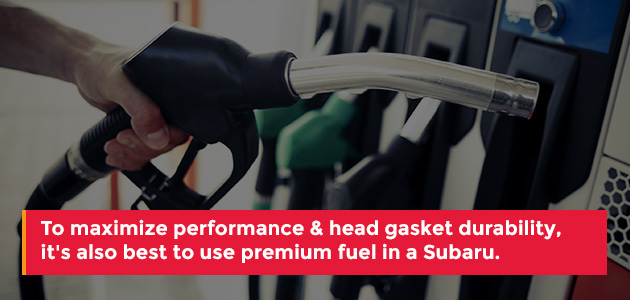
Now that you know how gaskets fail, the thing to focus on is preventative maintenance. For starters, fluid application should be dictated not by some instruction manual, but by the demands placed on a vehicle by your own driving habits. To maximize performance and head gasket durability, it’s also best to use premium fuel in a Subaru.
O.E.M. vs. Aftermarket Replacement Parts
The parts used in a Subaru model are also important, starting with the thermostat. In some used Subarus, the manufacturer thermostat will have been replaced by an inferior third–party product. Sometimes, this also happens in repair shops, where the technician will replace an old O.E. Subaru thermostat with a cheap imitation imported from China, the likes of which is bound to wear out sooner and cause damage to the head gasket. It should also be noted that aftermarket thermostats are generally too small in dimension and miscalibrated temperature–wise for Subarus, and thus restrict coolant flow in the vehicles. Bottom line, a Subaru vehicle should only be equipped with a Subaru thermostat.
Improvements in Newer Subaru Models
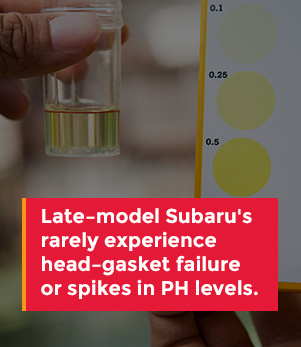
On models manufactured after 2003, Subaru has made its gaskets more corrosion–resistant. Additionally, the automaker has added more ground straps to its cars. As a result, as long as they’re regularly serviced, late–model Subarus less frequently experience head–gasket failure or spikes in pH levels.
Cooling System Chemistry
The solutions that go into the cooling system must have proper chemistry, or else corrosion can develop and spread to the ground cable. Faulty chemistry and corrosion are a common problem on older 2.5L models, in which coolant tends to leak from the left–side cylinder. This problem has largely decreased since Subaru added ground straps, which protect the most vulnerable part of the head gasket.
Heating Problems on Newer Subaru Models

Cars made by Subaru since 2005 are likelier to leak oil than coolant, but the biggest abnormality in the newer models their tendency to develop warped cylinders. This is due to the reordering of engine components within the newer vehicles, which have larger combustion areas. One of the biggest changes is the closer proximity of the engine and the catalytic converter, which has increased the flow of exhaust heat onto the cylinder heads, which explains for the warping.
The Average Cost of a Head Gasket Fix
While prices can vary from one state to another, head gasket repairs are generally up in the four–figure range. In New York, for example, repairs are known to pass the $3,000 mark. You can save a lot of money and, if needed, budget repairs accordingly by using advanced, mechanic-proven stop–leak products.
Stop–Leak Products vs. Engine Block Repair

Bar’s Leaks has OEM–verified solutions on hand for a vast range of vehicular issues, including coolant and oil leaks. You might have been quoted a hefty price for a head gasket repair or engine block fix at another service center, but there are other ways around that problem. Our products will simply remedy the leak and get you back out on the road promptly, all at just a sliver of what you could end up paying for a full mechanical repair.
- Blown Head Gasket Repair (p/n HG-1). The most powerful, tech-proven blown head gasket solution money can buy.
- Main Seal Motor Oil Leak Repair (p/n MS-1). A commercial-grade, mechanic-tested oil leak repair solution that is safe and effective for all vehicles, no mechanical expertise necessary. Guaranteed.
- Liquid Aluminum Cooling System Radiator & Heater Core Stop Leak (p/n 1186). By far our most popular cooling system solution, and incredibly easy to install. Over 100M bottles sold.
Every Bar’s Leaks product is guaranteed safe, effective and easy to use. Our products stop the majority of minor and moderate leaks in areas that are often far too costly to repair outright. From the head gasket and cooling system to the power steering and hydraulic jacks, our chemical tools can solve the problem, regardless of where a leak is coming from. You can stock up on our products for whenever you might need them on the road; applying them is easy and requires no automotive expertise.
Bar’s Leaks: Helping Motorists Since the 1940s

For 70 years, Bar’s Leaks has been owned and operated by the same family on the outskirts of Detroit, Michigan (aka Hockeytown; Motown; The Motor City). Having sold hundreds of millions of products to motorists from around the country, Bar’s Leaks has a national reputation for providing customers with expertise and proven chemical formulations that make vehicles run longer and better. Our chemical engineers keep abreast of the latest innovations in automotive technology, and products are regularly updated to accommodate these changes. Bar’s Leaks products are sold with a satisfaction guarantee, and the Head Seal Blown Head Gasket Repair (p/n HG-1) and Valve Seal Oil Consumption Repair (p/n VS-1) products carry a lifetime guarantee.
Become an Instant Mechanic with Bar’s Leaks Stop–Leak Products
At Bar’s Leaks, our goal is to see our customer gain the power to fix automobiles in a matter of minutes. For almost seven decades, our products have made instant mechanics out of motorists with a variety of vehicles, makes and models. To find the Bar’s Leaks location nearest to you, visit our locator page and type in your zip code.

